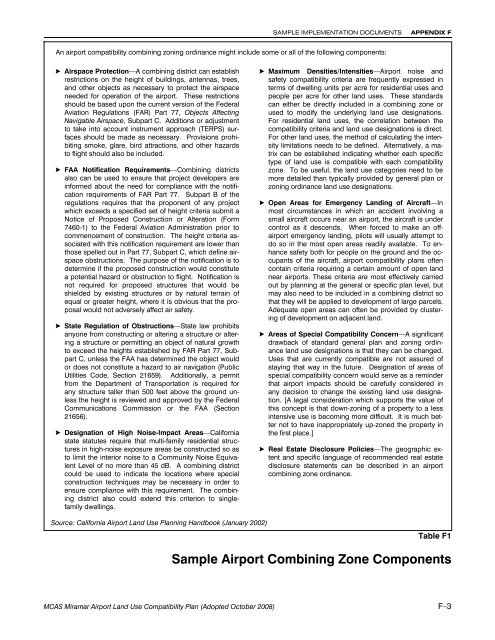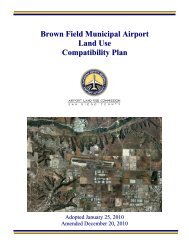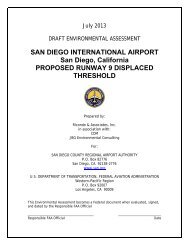MCAS Miramar Airport Land Use Compatibility Plan - San Diego ...
MCAS Miramar Airport Land Use Compatibility Plan - San Diego ...
MCAS Miramar Airport Land Use Compatibility Plan - San Diego ...
You also want an ePaper? Increase the reach of your titles
YUMPU automatically turns print PDFs into web optimized ePapers that Google loves.
SAMPLE IMPLEMENTATION DOCUMENTSAPPENDIX FAn airport compatibility combining zoning ordinance might include some or all of the following components: Airspace Protection—A combining district can establishrestrictions on the height of buildings, antennas, trees,and other objects as necessary to protect the airspaceneeded for operation of the airport. These restrictionsshould be based upon the current version of the FederalAviation Regulations (FAR) Part 77, Objects AffectingNavigable Airspace, Subpart C. Additions or adjustmentto take into account instrument approach (TERPS) surfacesshould be made as necessary. Provisions prohibitingsmoke, glare, bird attractions, and other hazardsto flight should also be included. FAA Notification Requirements—Combining districtsalso can be used to ensure that project developers areinformed about the need for compliance with the notificationrequirements of FAR Part 77. Subpart B of theregulations requires that the proponent of any projectwhich exceeds a specified set of height criteria submit aNotice of Proposed Construction or Alteration (Form7460-1) to the Federal Aviation Administration prior tocommencement of construction. The height criteria associatedwith this notification requirement are lower thanthose spelled out in Part 77, Subpart C, which define airspaceobstructions. The purpose of the notification is todetermine if the proposed construction would constitutea potential hazard or obstruction to flight. Notification isnot required for proposed structures that would beshielded by existing structures or by natural terrain ofequal or greater height, where it is obvious that the proposalwould not adversely affect air safety. State Regulation of Obstructions—State law prohibitsanyone from constructing or altering a structure or alteringa structure or permitting an object of natural growthto exceed the heights established by FAR Part 77, SubpartC, unless the FAA has determined the object wouldor does not constitute a hazard to air navigation (PublicUtilities Code, Section 21659). Additionally, a permitfrom the Department of Transportation is required forany structure taller than 500 feet above the ground unlessthe height is reviewed and approved by the FederalCommunications Commission or the FAA (Section21656). Designation of High Noise-Impact Areas—Californiastate statutes require that multi-family residential structuresin high-noise exposure areas be constructed so asto limit the interior noise to a Community Noise EquivalentLevel of no more than 45 dB. A combining districtcould be used to indicate the locations where specialconstruction techniques may be necessary in order toensure compliance with this requirement. The combiningdistrict also could extend this criterion to singlefamilydwellings. Maximum Densities/Intensities—<strong>Airport</strong> noise andsafety compatibility criteria are frequently expressed interms of dwelling units per acre for residential uses andpeople per acre for other land uses. These standardscan either be directly included in a combining zone orused to modify the underlying land use designations.For residential land uses, the correlation between thecompatibility criteria and land use designations is direct.For other land uses, the method of calculating the intensitylimitations needs to be defined. Alternatively, a matrixcan be established indicating whether each specifictype of land use is compatible with each compatibilityzone. To be useful, the land use categories need to bemore detailed than typically provided by general plan orzoning ordinance land use designations. Open Areas for Emergency <strong>Land</strong>ing of Aircraft—Inmost circumstances in which an accident involving asmall aircraft occurs near an airport, the aircraft is undercontrol as it descends. When forced to make an offairportemergency landing, pilots will usually attempt todo so in the most open areas readily available. To enhancesafety both for people on the ground and the occupantsof the aircraft, airport compatibility plans oftencontain criteria requiring a certain amount of open landnear airports. These criteria are most effectively carriedout by planning at the general or specific plan level, butmay also need to be included in a combining district sothat they will be applied to development of large parcels.Adequate open areas can often be provided by clusteringof development on adjacent land. Areas of Special <strong>Compatibility</strong> Concern—A significantdrawback of standard general plan and zoning ordinanceland use designations is that they can be changed.<strong>Use</strong>s that are currently compatible are not assured ofstaying that way in the future. Designation of areas ofspecial compatibility concern would serve as a reminderthat airport impacts should be carefully considered inany decision to change the existing land use designation.[A legal consideration which supports the value ofthis concept is that down-zoning of a property to a lessintensive use is becoming more difficult. It is much betternot to have inappropriately up-zoned the property inthe first place.] Real Estate Disclosure Policies—The geographic extentand specific language of recommended real estatedisclosure statements can be described in an airportcombining zone ordinance.Source: California <strong>Airport</strong> <strong>Land</strong> <strong>Use</strong> <strong>Plan</strong>ning Handbook (January 2002)Table F1Sample <strong>Airport</strong> Combining Zone Components<strong>MCAS</strong> <strong>Miramar</strong> <strong>Airport</strong> <strong>Land</strong> <strong>Use</strong> <strong>Compatibility</strong> <strong>Plan</strong> (Adopted October 2008) F–3
















